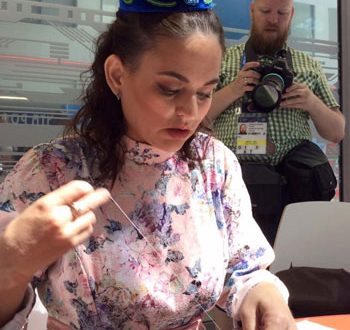Tyubeteyka – the best gift
14.07. 2018
There is no, perhaps, more bright and memorable Tatar souvenir than skullcap.
The history of the national headgear and the technology of its production by journalists of the city press center FIFA in Kazan has been introduced today by the master Guzel Timerbulatova. Today, the skullcap is an important part of the Muslim costume. Some wear this headdress every day. But most of them wear skullcaps only on special occasions. For example, during visiting the mosque, niqakh or other important family or religious events. This headpiece is always a welcome gift to a believer (however, not necessarily). As a sign of respect for his religion, position, age …
Tyubeteika is still worn as a symbol of belonging to certain nationalities and religions, says Guzel Timerbulatova, however for most urban Tatars the skullcap performs more decorative functions.
In the Volga Tatars, the skull cap from the earliest times performed a more practical function and served as a “balaclava” for soldiers. Such a headdress looked more like an Uzbek skull cap, clinging to the head. “In the XIX century and later, at the time of Gabdulla Tukai, changes in fashion began, and a form of skull-capsules from Turkey came close to the modern, already familiar to us, in territory of the Kazan region. That is, that “low” skullcap, which we know today, was not originally a Tatar national headdress, it’s a Europeanized version,” Guzel explained. By appearance of the skullcap it could be judged not only the wealth, age and class of its owner, but also about the type of his occupation. Women’s skullcap is smaller in size than men’s, it covers only the top. Together with the hostess age, a headdress also was growing – young girls had very miniature skullcaps, whereas older ladies tried to remove hair under it. Embroidery on women’s skullcaps was more diverse and richer, and the forms of ornaments were more rounded. Tyubeteika is still worn as a symbol of belonging to certain nationalities and religions, says Guzel Timerbulatova, however for most urban Tatars the skullcap performs more decorative functions. All the products of Guzel are handmade. She chose velvet and beads for her skullcaps and works only with these “noble” materials. She says that this way headgear looks more elegant, colorful. Of course, today skullcaps are sewn in factories, but to embroider them with beads so elegantly is not possible in production. “It is impossible to embroider beads on an industrial scale. And all what I am doing – a handmade work, “the craftswoman proudly remarked.
She warned that the whole skullcap can not be made within one master class – it takes about two weeks to tailor and decorate one such “cap”, depending on the complexity of the pattern and size. But the gathered (the girls mostly, of course) did not become discouraged, as they were entrusted to expand rectangles of cloth with beads, and the selection of shiny pebbles is a very fascinating occupation! And although nobody managed to take home his own skullcap yesterday, journalists and volunteers felt like real Tatar couturiers.
rt-online.ru

